In every programming language, various types of errors occur at runtime or compile time. There is an error named “KeyError” that occurs at runtime. It is raised when the accessed key is not in the input dictionary. The “KeyError: 0 exception” in Python means accessing the “0” key in the dictionary, which does not contain the key.
This write-up provides various causes and solutions for the “KeyError: 0 exception” in Python with multiple examples. The following reason and solutions are discussed in this post:
- Reason: Key Can Not be Located in Dictionary
- Solution 1: Using the get() Method
- Solution 2: Using try-except Block
- Solution 3: Set Specific Key Value
- Solution 4: Using For loop
- Solution 5: Using defaultdict Class
So let’s get started!
Reason: Key Can Not be Located in Dictionary
The “KeyError: 0 exception” in Python occurs when the key value is not located in the dictionary.
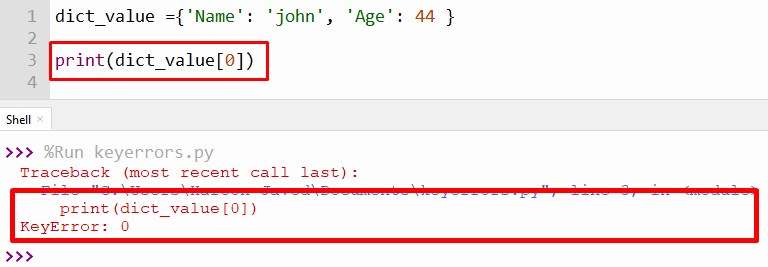
The above snippet shows the “KeyError: 0” exception because the “0” key name does not exist in the given dictionary.
Solution 1: Using the get() Method
The “get()” method is used in Python to handle the “KeyError: 0 exception”. If the value is not present in the dictionary, the “get()” method returns the default value “None”. The returned value can also be modified by placing it as the second parameter. Here the given below snippet shows the code to handle the “KeyError” exception in Python:
Code:
dict_value ={'Name': 'john', 'Age': 44 }
print(dict_value.get(0))
print(dict_value.get(0, 'Alex'))
In the above code, the “None” value will return when “0” is placed inside the parentheses of the “get()” method. To modify the returned value, the value named “Alex” is placed as the second parameter.
Output:
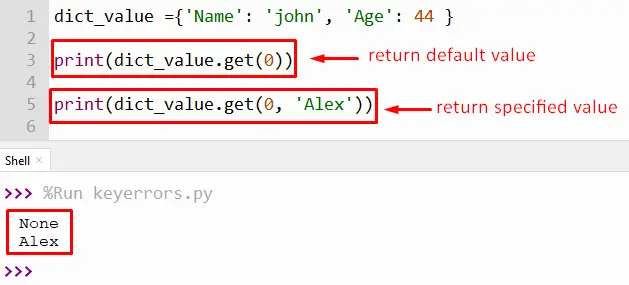
The “get()” method used in the above code returns “None” if the key value does not exist in the dictionary.
Solution 2: Using try-except Block
To handle the “KeyError: 0 exception” the “try-except” block is used in Python.
Code:
dict_value ={'Name': 'john', 'Age': 44 }
try:
print(dict_value[0])
except KeyError:
print('Key does not present')
In the above code, the “0” is not defined in the dictionary, so the error that arises will be handled through the “try-except” block.
Output:
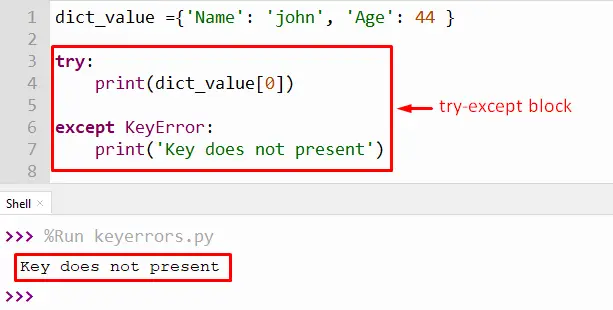
The above output proves that the “try-except” block successfully handles the “KeyError: 0 exceptions” in the Python program.
Solution 3: Set Specific Key Value
We can also set the value for a specific key before accessing it in the program.
Code:
dict_value ={'Name': 'john', 'Age': 44 }
dict_value[0] = []
dict_value[0].extend(['a','b','c','d'])
print(dict_value[0])
In the above code, an empty list is assigned to key “0”, which is not present in the given dictionary. The “extend()” function is used to append the list to an empty list. When the key “0” is accessed, the assigned value is printed on the screen without error.
Output:
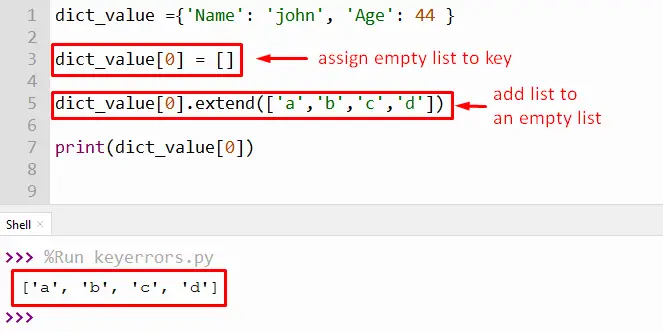
The above output shows that the “extend()” method adds the value of the new list to an empty list stored in a key named “0”.
Solution 4: Using For loop
To fix this error, the “for loop” can be used to iterate over the dictionary key and print the value of those keys present in the dictionary.
Code:
dict_value ={4: 'John', 2: 'Lily', 1: 'David' }
for i in range(0,6):
if i in dict_value:
print(dict_value[i])
else:
continue
In the above code, the “for” loop iterates over the input dictionary key and prints all the dictionary values if the range value is present in the dictionary.
Output:
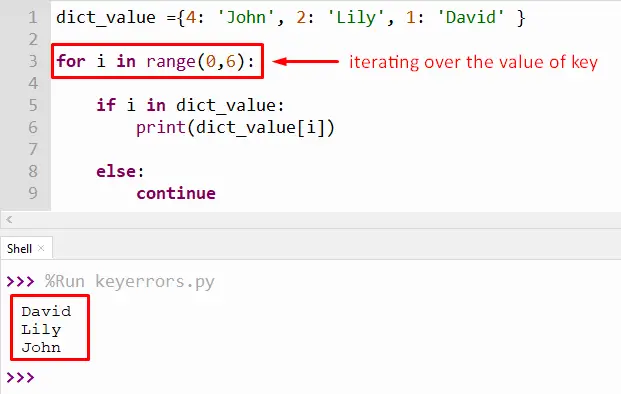
The above output shows all the values stored in a dictionary by using the “for” loop iterator.
Solution 5: Using defaultdict Class
The “defaultdict” class is also used in Python to fix the “KeyError”.
Code:
from collections import defaultdict
dict_value = defaultdict(list)
dict_value[0].extend(['a','b','c'])
print(dict_value)
In the above code, the “defaultdict” is accessed using the module named “collections” and the list class is passed as the argument to the “defaultdict” function.
Output:

From the above output, it is verified that the new list is stored in a key-value “0”.
That’s it from this guide!
Conclusion
The “KeyError: 0 exception” occurs in Python when the user tries to access a “0” key in the given dictionary where the key value is not present. To rectify this error, various methods are used, such as the get() method, try-except exception handling, set specific key value, using for loop, and using “defaultdict”. You can set the value of the key in the dictionary before accessing it to avoid key value errors in Python. This article presented the reason and various solutions for “KeyError: 0 exception” in Python with appropriate examples.
